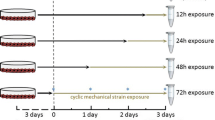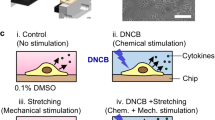Summary
In vivo, epidermal cells are committed to terminal differentiation in which they undergo a series of morphological and biochemical changes. In vitro, keratinocytes are able to undergo some steps of this differentiation process only. In view of the fact that in vivo skin is continuously subjected to mechanical stress, we investigated the stimulation of differentiation of transformed keratinocytes by mechanical stimulation. The cells, grown in plastic culture dishes, were periodically treated with weights exerting a pressure of 0.015 Ncm−2. This stimulation lasted from 1 to 4 days. Then keratinocytes were examined using indirect immunofluorescence, 3H-thymidine and 14C-amino acid incorporation, SDS polyacrylamide gel electrophoresis, and Western blotting. Following pressure treatment, the previously monolayered keratinocytes locally grew up to several layers, the number of horny scales increased and, after 4 days, the pattern of cytokeratin was modified. The total amount of keratin increased, forming granular accumulations, while the proliferation rate of the cells decreased. Both the 67 kDa and 49.5 kDa keratin subunits increased in stimulated cells. Moreover, a weak keratin band of 44 kDa appeared that was not present in controls. The results demonstrate that cyclic pressure promotes differentiation of cultivated epidermal cells.
Similar content being viewed by others
References
Asselineau D, Bernard BA, Bailly C, Darmon M, Pruniéras M (1986) Human epidermis reconstructed by culture: Is it “normalℍ? J Invest Dermatol 86:181–186
Bereiter-Hahn J, Anderson OR, Reif WE (eds), (1987) Cytomechanics. Springer-Verlag, Berlin Heidelberg New York
Bernd A, Wehrenberg O, Hevert F, Holzmann H (1988) Experimenteller und klinischer Nachweis der antiproliferativen Wirkung einer hochgereinigten Steinkohlenteer-Fraktion in einer speziellen Gelgrundlage. Arzneimittelforsch Drug-Research 38:3–7
Bohnert A, Hornung J, Mackenzie IC, Fusenig NE (1986) Epithelial-mesenchymal interactions control basement membrane production and differentiation in cultured and transplanted mouse keratinocytes. Cell Tissue Res 244: 413–429
Boukamp P, Tilgen W, Dzarlieva RT, Breitkreutz D, Haag D, Riehel RK, Bohnert A, Fusenig NE (1982) Phenotypic and genotypic characteristics of a cell line from a squamous cell carcinoma of human skin. JNCI 68:415–427
Boukamp P, Petrusevska RT, Breitkreutz D, Hornung J, Markham A, Fusenig NE (1988) Normal keratinization in a spontanously immortalized uneuploid human keratinocyte cell line. J Cell Biol 106:761–771
Curtis ASG, Seehar GM (1978) The control of cell division by tension or diffusion. Nature 274:52–53
Fuchs E, Green H (1980) Changes in keratin gene expression during terminal differentiation of the keratinocyte. Cell 19:1033–1042
Fuchs E, Green H (1981) Regulation of terminal differentiation of cultured human keratinocytes by vitamin A. Cell 25:617–625
Fusenig NE (1986) Mammalian epidermal cells in culture. In: Bereiter-Hahn J, Maltoltsy AG, Richards KS (eds) Biology of the integument, vol 2. Springer-Verlag, Berlin Heidelberg New York, pp 409-436
Hennings H, Michael D, Cheng C, Steinert P, Holbrook K, Yuspa H (1980) Calcium regulation of growth and differentiation of mouse epidermal cells in culture. Cell 19:245–254
Khong TY, Lane EB, Robertson WB (1986) An immunocytochemical study of fetal cells at the maternal-placental interface using monoclonal antibodies to keratins, vimentin and desmin. Cell Tissue Res 246:189–195
Laemmli UK (1970) Cleavage of structural proteins during the assembly of the head of bacteriophage T4. Nature 22:680–685
Lavker RM, Maltoltsy AG (1970) Formation of horny cells. The fate of cell organelles and differentiation products in numinal epithelium. J Cell Biol 44:501–512
Maltoltsy AG (1986) Structure and function of the mammalian epidermis. In: Bereiter-Hahn J, Maltoltsy AG, Richards KS (eds) Biology of the integument, vol 2. Springer-Verlag, Berlin Heidelberg New York, pp 255–268
Moll R, Franke WW, Schiller D (1982) The catalog of human cytokeratins: patterns of expression in normal epithelia, tumors and cultured cells. Cell 31:11–24
Pentland A, Marcello CL, Jordan MA, Voorhees JJ (1986) Effects of gas tension on epidermal keratinocyte DNA synthesis and prostaglandin production. J Invest Dermatol 86:177–180
Régnier M, Schweizer J, Michel S, Bailly C, Pruniéras M (1986) Expression of high molecular weight (67 K) keratin in human keratinocytes cultured on dead deepidermized dermis. Exp Cell Res 165:63–72
Southern EM (1975) Detection of specific sequences among DNA fragments separated by gel electrophoresis. J Mol Biol 98:503–517
Sun TT, Green H (1976) Differentiation of the epidermal keratinocyte in cell culture: formation of the cornified envelope. Cell 9:511–521
Takeuchi S (1979) Wound Healing in the cornea of the chick embryo. IV. Promotion of the migratory activity of isolated corneal epithelium in culture by the application of tension. Dev Biol 70:232–240
Troyanowsky SM, Bannikow GA, Montesano R, Vasiliev JM (1986) Density-dependent expression of keratins in transformed rat liver cell lines. Cell Biol Int Rep 10:263–270
Uchida A, Yamashita K, Hashimoto K, Shimomura Y (1988) The effect of mechanical stress on cultured growth cartilage cells. Connect Tissue Res 17:305–311
Vandenburgh HH (1982) Dynamic mechanical orientation of skeletal myofibers in vitro. Dev Biol 93:433–438
Vandenburgh HH (1989) A computerized mechanical cell stimulator for tissue culture: effects on skeletal muscle organogenesis. In Vitro Cell Dev Biol 24:609–619
Author information
Authors and Affiliations
Additional information
Dedicated to Prof. Dr. G. W. Korting, 23 September 1989
Rights and permissions
About this article
Cite this article
Görmar, F.E., Bernd, A., Bereiter-Hahn, J. et al. A new model of epidermal differentiation: Induction by mechanical stimulation. Arch Dermatol Res 282, 22–32 (1990). https://doi.org/10.1007/BF00505641
Received:
Issue Date:
DOI: https://doi.org/10.1007/BF00505641




